#Grozfarwat
Explore tagged Tumblr posts
Text
Bestiaryposting Results: Miscellaneous Birds
So! This is the first in our six-week wind-down of Bestiaryposting, where we run through the Honorable Mentions that appear in the Aberdeen Bestiary but didn't get their own post here because the author of the Bestiary and I have different goals.
If you don't know what any of that means, you can find out at https://maniculum.tumblr.com/bestiaryposting.
To see the entry our artists are working from, click here:
To see the entry people are drawing now, so that you can potentially join in, click here:
Art is below the cut, in roughly chronological order.
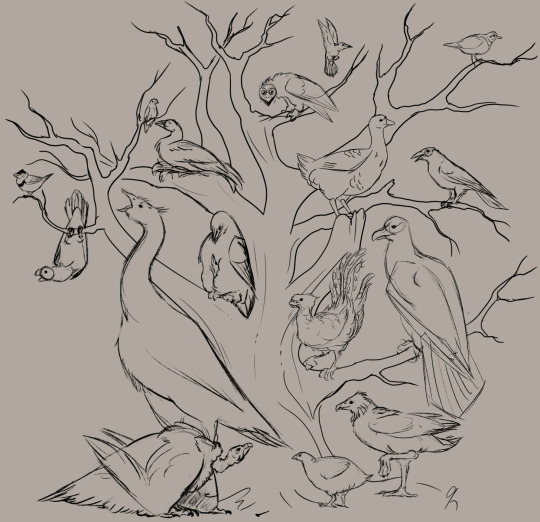
@silverhart-makes-art (link to post here) decided to do Literally All of the birds. I am fascinated by the detail here; I particularly like the pose on the Hreakgleav, and the feathers on the Klethghrom. I would direct anyone trying to figure out which is which to the linked post, which contains a key and brief descriptions of each.
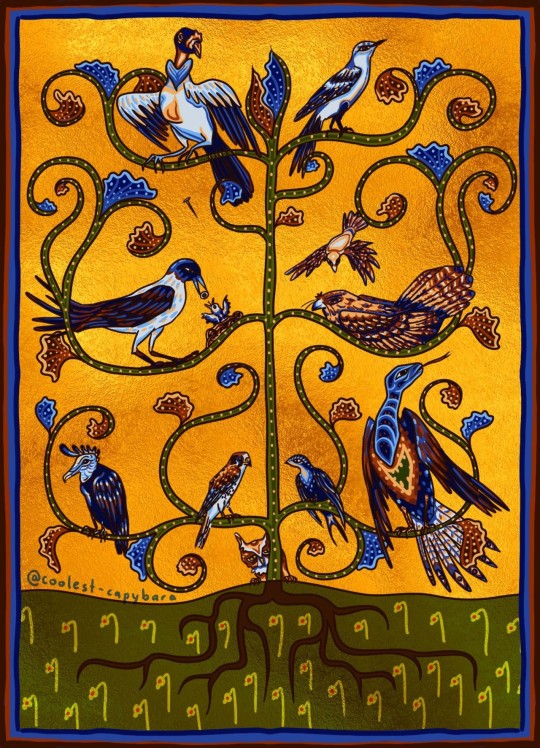
@coolest-capybara (link to post here) has also given us a tree full of birds. The explanation in the linked post of which is which and what they were inspired by is illuminating (pun not intended), so check that out. I especially enjoy the interpretations of the Klethghrom and the Lokfotreag. (And thank you for providing alt text.)

@wendievergreen (link to post here) has drawn three of the birds in their always-charming style. For explanations, close-ups, and individual treatments of each, please see the linked post. I really like the tail on the Hreakgleav and the... frankly insane look of the Klethghrom. (Also thank you for providing alt text.)
All right, we're going to identify these rapid-fire because there are a bunch of them and I'm not going to hand you a whole-ass essay here. Readers are encouraged to add their own commentary.
Tluftasong
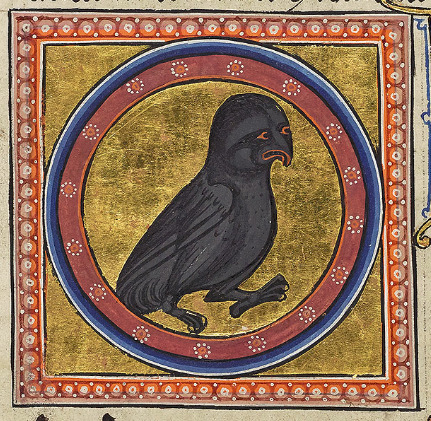
The manuscript identifies this one as "night owl", but I've seen other sources refer to this entry as the "night heron". I'll leave that one to people who know birds more.
Lokfotreag

This is the hoopoe. Which, as listeners to the podcast know, you can trade to demons for perpetual access to great parties. The illustration is very cool, and seems to show the young birds rejuvenating their aging parent.
Hurrashbeg
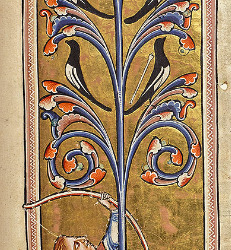
Really love the Stylized Plant, of course. One of the things that really strikes me about medieval manuscript art is how particular things that Definitely Don't Exist keep cropping up in different manuscripts, looking pretty much the same. Like, unless this is by the same artist who did the Rutland Psalter, it shows an interestingly consistent artistic tradition -- I swear that's the exact same plant, and in a couple other places in the manuscript they have the exact same wyvern.
Anyway, those are clearly magpies. I don't know why they're being shot at.
Konchilkuk
This one didn't get an illustration, but it's the woodpecker.
Wobrahfmet
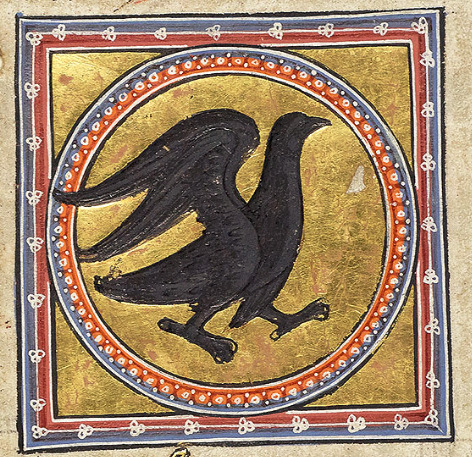
Yep, that sure is a raven. They actually have a really long entry, but it's mostly about what they symbolize.
Hrongnewit
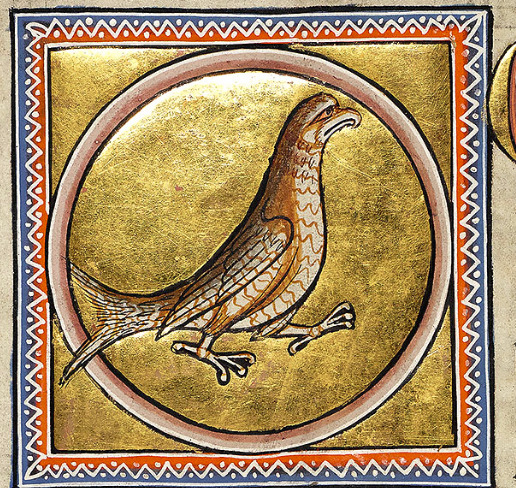
This one is the kite. Yeah, that looks pretty believable.
Klomurgrae
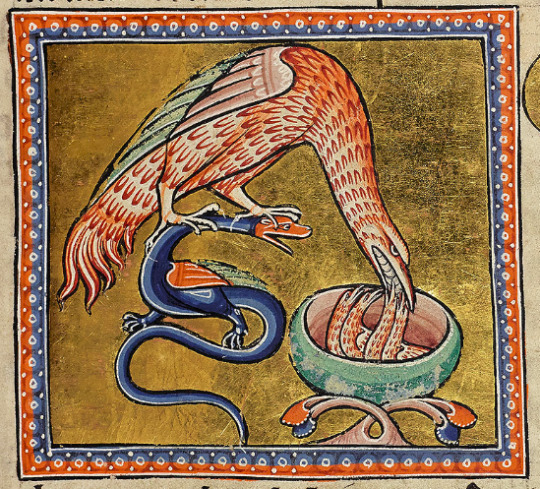
This is... apparently the ibis. Also, from the context of the entry, I think it's intended to be standing on a snake. Neither of those look like the things they are supposed to be.
Zagsmenrok

This is the blackbird. I have no explanation for why it's brown. The illustrator clearly has access to black ink.
Hreakgleav
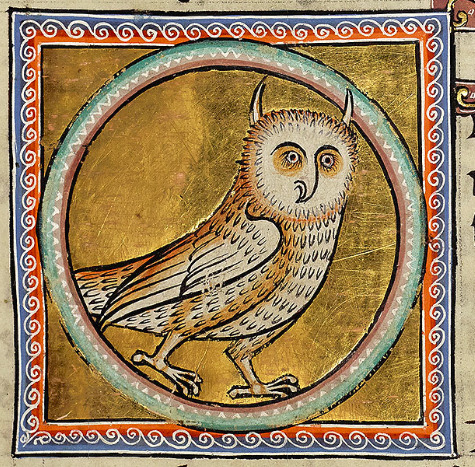
Yep, that's very clearly an owl.
Wahrembeag
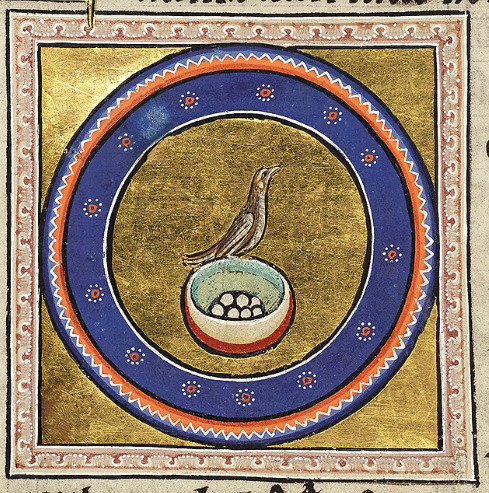
It tickles me that these are right next to each other, because there's a moderately-well-known Middle English poem called "the Owl and the Nightingale". This is pure coincidence; they're not together in the bestiary, there are a few birds in between.
Oh yeah, this is the Nightingale.
Sarbrufeat

This is the heron. The illustration seems broadly correct, but do herons come in white? That's an egret, surely.
Keltrumram

This is the coot -- doesn't look like one to me, but maybe the artist and I are familiar with different species of coot. Readers may recall its cameo in the Eagle entry; its own is unfortunately rather shorter.
Grozfarwat

Meet the quail. I was initially confused, but apparently the plume thing I associate with quails is not actually common to all species of quail. So... yeah, good quail.
Mortelgeng

Very definitely a crow.
Burngraega

Also very identifiable, here's the swan. Head and beak seem a bit flatter and wider than I would expect, though.
Klethghrom

This was basically the poster child for "too obvious to get its own entry". Here's the peacock.
And that's it for this week, it's late. Talk amongst yourselves, or tell me what you think about all these birds.
#maniculum bestiaryposting#miscellaneous birds#maniculum miscellaneousbirds#Tluftasong#Lokfotreag#Hurrashbeg#Konchilkuk#Wobrahfmet#Hrongnewit#Klomurgrae#Zagsmenrok#Hreakgleav#Wahrembeag#Sarbrufeat#Keltrumram#Grozfarwat#Mortelgeng#Burngraega#Klethghrom
28 notes
·
View notes
Text
Miscellaneous Other Birds

...I'm counting sixteen. No, that one doesn't count, there's still only sixteen.
Following Silverhart's lead, I've left off the names on the initial image so you can guess which is which—some I feel are rather obvious and others rather not. Under the cut I'll put the version with every bird labelled.
Some birds have inspiration from existing birds. A few have very direct inspiration, in that I had a bird field guide with me while drawing and, in the case the bestiary entry didn't spark anything solid, would open it to a random page and use whatever it was as inspiration or reference. I don't remember most of these.
Now, let's buckle in for:
Rapid-Fire Birdbuilding
The Tluftasong
The Tluftasong is a nocturnal bird native to Eastern Europe. It bears strong resemblance to an owl, though it is unrelated. It is roughly seven inches from bill to tailtip, and has sooty grey feathers.
A Tluftasong eats insects and nests in hollows and in the eaves of abandoned buildings. Its pupils are extremely dilated, and are unable to significantly change size. Because of this, Tluftasongs cannot safely open their eyes during daylight and are severely impacted by light pollution.
The Lokfotreag
The Lokfotreag is a bird found only in Scotland. Its body is covered in shaggy brown feathers, save for its head, which is bald, save for a bright red crest of feathers. It is incapable of long-distance flight, and primarily eats corpses.
(My intention with this one was to take "turkey vulture" a bit too literally, but it doesn't look very much like an actual turkey.)
The Hurrashbeg
The Hurrashbeg is a kind of corvid native to Ireland. Its feathers are mainly black, though the tips of its wings and tail and the top of its head are white. It is capable of mimicking sounds, though not as well as a parrot or raven, and is noted for doing so incredibly often.
The Konchilkuk
The Konchilkuk is a kind of woodpecker found in Southeast Asia. It is very easily identified as its body is covered in black-and-orange stripes.
The Wobrahfmet
The Wobrahfmet is a black bird found in all of Europe except for southern Europe. Its head is a slightly lighter shade than the rest of its body. It is not picky in its choice of food, and will dine on plants, insects, and corpses alike, and it makes a loud croaking call that can be heard from an impressive distance.
The Hrongnewit
The Hrongnewit is a small bird of prey—a foot in length at most—found throughout all of Europe except for northern Europe. Its feathers are a sandy brown, with a darker body than head and paler feathers on the undersides of its wings and the tip of its tail. It likes to prey on the chicks of domestic birds, if they are left unattended.
The Klomurgrae
The Klomurgrae is a shorebird native to the Midwestern and Northeastern United States. Its feathers are black with white stripes, and its head is bald. Much of its diet consists of washed-up corpses, though it will also dig in the sand for living invertebrates.
The Zagsmenrok
The Zagsmenrok is a tiny bird, four inches in length. It eats mainly seeds. There are two species of Zagsmenrok—one is found throughout almost all of Europe, and is black with a white beak, and the other is found only in Greece, and is white with a black beak.
(This one was based on a chimney swift! Got lucky with the bird book there—not sure what I'd have done if I'd landed on a duck or something.)
The Hreakgleav
The Hreakgleav is a bird native to Russia. It is covered in shaggy grey feathers, and makes a low croaking call. They are frequently seen nesting in manmade structures. They are omnivorous and will eat anything they can find, from seeds to corpses to small living animals to human garbage.
The Wahrembeag
The Wahrembeag is a songbird found throughout the United States and Canada. It is blue-grey in color, with white feathers along its wings, and it eats mainly insects. It is known for singing particularly loudly just before dawn year-round, and remaining silent the rest of the day when not in its spring mating season.
The Sarbrufeat
The Sarbrufeat is a bird of prey found mainly in Canada and the northern United States. Males of the species have white feathers with grey bands on their legs, while females have mottled grey feathers with white stripes on their chest and legs.
The Keltrumram
The Keltrumram is a waterbird found in the southern United States. It is known locally as the "fool's eagle" because the white plumage on its head causes some to mistake it for a bald eagle. It eats fish.
(I think I remember what this bird is, from the "eagle" week... so I designed something that might plausibly be mistaken for either bird. Assuming I remember right.)
The Grozfarwat
The Grozfarwat is a bird with blue-grey feathers and a broad wingspan. Its head is a brighter shade of blue, and it eats seeds, small fish, and invertebrates. Grozfarwats are known for migrating across the Atlantic Ocean, from Europe to South America.
The Mortelgeng
The Mortelgeng is a bird native to the Midwestern United States and parts of Canada. It is brown in color, with a grey underbelly and bright red spots on its face—for males, they encircle their eyes, and for females they are found only in the outside corners of their eyes. They eat insects and grain, and make a whistling call.
(This is probably my favourite of the birds. The Hurrashbeg and Grozfarwat are both vying for second.)
The Burngraega
The Burngraega is a bird found through Europe, particularly northern Europe. It has pure white feathers and a long neck, and lives near water. Burngraegas mainly eat fish and invertebrates.
The Klethghrom
The Klethghrom is a bird found mainly in Brazil. Its feathers are mainly green, with a dark blue chest, and the undersides of its wings are grey with rose-colored streaks. Its tail is long and dark, with dark blue-and-pink eyespots. It makes a cooing noise, and eats all manner of plant parts.

#maniculum miscellaneousbirds#tluftasong#lokfotreag#hurrashbeg#konchilkuk#wobrahfmet#hrongnewit#klomurgrae#zagsmenrok#hreakgleav#wahrembeag#sarbrufeat#keltrumram#grozfarwat#mortelgeng#burngraega#klethghrom#can't believe I typed all those out#bestiary#worldbuilding#fiction writing#strix draws things
8 notes
·
View notes
Text
A Mingling of Miscelaneous Birds

My response to this week’s BestiaryPosting challenge, from @maniculum
I figured that rather than picking out individual birds from the description, I'd try my hand at all of them; I gave myself approximately 5 minutes for each, with no pencil guides this time; Lines in TWSBI Eco fountain pen, extra fine nib, using Monteverde Raven Noir ink (how appropriate!).
Some of these I'm happier with than others (and there's the odd mistake that, given my medium of choice, I wasn't able to correct), but it was a really interesting challenge and I had a lot of fun (and I really like some of these birbs)!
Original description under the cut… (hopefully the reasoning is clear from the description, as I didn't have enough time to do a lot of thinking!)
Incidentally, the lyre is based on a reconstruction of the one from Sutton Hoo, and I only realised the Klomurgrae ate snake eggs and not snakes themselves looking back at the description after I'd drawn it :D
Tluftasong
The Tluftasong is a bird that loves the darkness of the night. It lives in decaying walls because it sets up house in the ruins of roofless dwellings. It shuns the light, flying at night in search of food. [This one got two entries somehow; above is the first, below is the second.] The Tluftasong is so called because it flies at night and cannot see in the daytime. For its sight is dimmed by brightness of the sun when it has risen. The Tluftasong is not the same as the owl, which is bigger.
Lokfotreag
When the bird called the Lokfotreag sees that its parents have grown old and that their eyes are dim, it plucks out their old plumage and licks their eyes and keeps them warm, and its parents’ life is renewed. [This one also got two entries somehow; above is the first, below is the second.] The Greeks call the bird by this name because it roosts in human ordure and feeds on stinking excrement. The filthiest of birds, it is capped with a prominent crest. It lives in burial places amid human ordure. If you rub yourself with its blood on your way to bed, you will have nightmares about demons suffocating you. Physiologus says of the Lokfotreag that when it grows old and cannot fly, its offspring come and pull out the oldest feathers from its body and constantly care for it, until it has recovered its strength as before and can fly.
Hurrashbeg
Hurrashbegs are like poets, because they utter words, with a distinct sound, like men; hanging in the branches of trees, they chatter rudely, and even if they cannot get their tongues round words, they nevertheless imitate human speech.
Konchilkuk
The Konchilkuk gets its name from [redacted], because he used it for taking auguries. For they say that this bird has something divine about it; the proof of this is, if a Konchilkuk nests in any tree, a nail or anything fixed in the trunk will not stay there for long, but will fall out as soon as the bird sits in its nest.
Wobrahfmet
The Wobrahfmet gets its name, [redacted], from the sound it makes in its throat, because it utters a croak. It is said that when its young have been hatched, this bird does not feed them fully until it sees that they have black feathers similar to its own. But after it has seen that they are of dark plumage, and has recognised them as of its own species, it feeds them more generously. When this bird feeds off corpses, it goes for the eyes first.
Hrongnewit
It is weak in strength and in flight — a puny bird, from which it gets its name, [redacted]. It is, however, a bird of prey, always preying on domestic birds. It constantly hovers around kitchens and meat-markets so that if pieces of raw meat are thrown out from them, it can seize them quickly. The Hrongnewit is timid in big matters, bold in small. It dares not seize wild birds but customarily preys on domestic ones. It lies in wait to seize their young and when it encounters unwary youngsters, it kills them quickly.
Klomurgrae
There is a bird called the Klomurgrae; it purges its stomach with its beak. It feeds on the eggs of snakes and on carrion, and from them carries back food to its young, which they eat with great pleasure. Yet it fears to go into water, because it does not know how to swim, but walks about near the shore day and night, looking for dead fish of a small size or corpses which have been washed up.
Zagsmenrok
Isidore says of the Zagsmenrok: ‘The Zagsmenrok in ancient times was called [redacted], because it sang rhythmically.’ Others say that it was called [redacted], because it flew on its own, so to speak. Although it is black wherever it is found, there is a white species in Achaia. The Zagsmenrok is small but black.
Hreakgleav
Isidore says of the Hreakgleav: ‘The name of the Hreakgleav, [redacted], is formed from the sound it makes. It is a bird associated with the dead, weighed down, indeed, with its plumage, but forever hindered, too, by the weight of its slothfulness. It lives day and night around burial places and is always found in caves.’ It is said to be a filthy bird, because it fouls its nest with its droppings, as the sinner dishonours those with whom he lives, by the example of his evil ways. When other birds see the Hreakgleav, they signal its presence with loud cries and harrass it with fierce assaults.
Wahrembeag
The Wahrembeag is so called because it signals with its song the dawn of the new day; a light-bringer, so to speak. It is an ever-watchful sentinel, warming its eggs in a hollow of its body, relieving the sleepless effort of the long night with the sweetness of its song. It seems to me that the main aim of the bird is to hatch its eggs and give life to its young with sweet music no less than with the warmth of its body.
Sarbrufeat
It is called Sarbrufeat, [redacted] because of its capacity to fly high in the sky; it fears rain and flies above the clouds to avoid experiencing the storms they bring. A Sarbrufeat taking wing shows a storm is coming. Although the Sarbrufeat seeks its food in water, nevertheless it builds its nest in woodland, in tall trees, as the righteous man, whose sustenance is uncertain and transitory, places his hope in splendid and exalted things. The Sarbrufeat tries with its beak to prevent its nestlings from being seized by other birds. Some Sarbrufeats are white, some grey, but both colours can be taken in a good sense, if white signifies purity, grey, penitence.
Keltrumram
It is a winged creature, fairly clever and very wise; it does not feed on corpses and it does not fly or wander aimlessly but stays in one place until it dies, finding both food and rest there. Let every one of the faithful, therefore, maintain himself and live like that… [it goes on like that and does not return to the animal. However, the following paragraph is from the “eagle” entry.] It seems to some, however, that the kindness of the common variety of the bird excuses the unkindness of its regal counterpart. The ordinary bird is called [redacted], Keltrumram; in Greek, [redacted]. Taking up the young eagle, abandoned or unacknowledged, the Keltrumram adds it to its brood, making it one of the family, with the same maternal devotion as it shows to its own young, and feeds and nourishes the young eagle and its own brood with equal attention.
Grozfarwat
Grozfarwats have fixed times of migration. For when summer gives way to winter, they cross the sea. The leader of the flock is called ‘the Grozfarwat-mother’. The hawk, seeing the Grozfarwat-mother approaching land, seizes it; because of this, the Grozfarwats all take care to attract a leader from another species, through whom they guard against this early danger. Their favorite food is the seed of poisonous plants. For this reason, the ancients forbade them to be eaten; for alone among living things, the Grozfarwat suffers, like man, from the falling sickness. Grozfarwats have fixed times of migration. For when summer gives way to winter, they cross the sea.
Mortelgeng
The Mortelgeng is a long-lived bird, called [redacted] in Latin and Greek. Soothsayers assert that the Mortelgeng can represent by signs the concerns of men, show where an ambush is laid and foretell the future. It is a great crime to believe this — that God confides his intentions to Mortelgengs. Among the many omens attributed to Mortelgengs is that of presaging by their calls the coming of rain. Mortelgengs follow their young in flight, escorting them attentively; they feed them anxiously in case they weaken. A very long time passes before they give up their responsibility for feeding their offspring.
Burngraega
It is called [redacted] because its plumage is wholly white; no-one can recall seeing a black Burngraega. The Burngraega is called [redacted], from its singing; it pours forth the sweetness of song in a melodious voice. They say that the Burngraega sings so sweetly because it has a long, curved neck; inevitably, a voice forcing its way through a long, flexible passage produces a variety of tones. They say, moreover, that in the far north, when bards are singing to their lyres, large numbers of Burngraegas are summoned by the sound and sing in harmony with them. Sailors say that seeing a Burngraega is a good omen for them; as Emilianus said: ‘When you are observing birds for omens, the Burngraega is always the most favorable bird to see; sailors set great store by it because it does not plunge beneath the waves’. The Burngraega has snow-white plumage and dark flesh. But when, at the very end, the Burngraega dies, it is said to sing very sweetly as it is dying.
Klethghrom
The Klethghrom gets its name, [redacted], from the sound of its cry. Its flesh is so hard that it hardly decays and it cannot easily be cooked. A certain poet said of it: ‘You are lost in admiration, whenever it spreads its jewelled wings; can you consign it, hard-hearted woman, to the unfeeling cook?’ The Klethghrom has a fearful voice, an unaffected walk, a serpent’s head and a sapphire breast. It also has on its wings feathers tinged with red. In addition, it has a long tail, covered with what I might call ‘eyes’.
#maniculum bestiaryposting#my art#bestiaryposting#birbs#Tluftasong#Lokfotreag#Hurrashbeg#Konchilkuk#Wobrahfmet#Hrongnewit#Klomurgrae#Zagsmenrok#Hreakgleav#Wahrembeag#Sarbrufeat#Keltrumram#Grozfarwat#Mortelgeng#Burngraega#Klethghrom#maniculum miscellaneousbirds
7 notes
·
View notes
Text

This week's Bestiary Posting is a doozy. We've got quite a collection of miscellaneous birds, and I decided I would just draw them all, for whatever reason. No color this week though, since I'm lazy, and also my computer is acting up, so I'm just gonna call it done before it crashes on me again.
Below I give a quick little blurb about each bird's inspiration, and under that the same picture with the birds labeled so you can guess for yourself which bird is which, and then scroll down to see if you were right.
Tluftasong - demon lovechild of an owl and a potoo Lokfotreag - a chickadee-type bird with a casque Hurrashbeg - a parrot that hangs upside down like a bat Konchilkuk - no real reason for this design other then I wanted a bird that looked smug Wobrahfmet - a corvid with a bald head Hrongnewit - a hummingird-kestrel creature on account of it 'hovering' around kitchens and meat markets Klomurgrae - an Egyptian vulture but with the long legs of a wading bird - I think he looks very charming Zagsmenrok - teeny little bird with a bit of a feather crest over it's eyes and beak like a helmetshrike Hreakgleav - a shaggy vulture with the posture of a bat Wahrembeag - a penguin-gull with a brood patch that has evolved into a marsupial-style pouch - might be my favorite of the bunch Sarbrufeat - bar-headed goose inspired, but with a hooked beak to fend off chick snatchers Keltrumram - a flightless pheasant/moorhen type of bird. Very round, very cuddly Grozfarwat - a little kildeer inspired bird Mortelgeng - if an albatross became an eagle for some reason Burngraega - a terrifying swan-heron beast - would make them bigger if it would've fit because I think the idea of giant stick birds with haunting voices is awesome Klethghrom - a crested pheasant with a beak like a snake's head

And that's all the birds.
13 notes
·
View notes
Text
Bestiaryposting -- Miscellaneous Birds
As a reminder, all previous entries in this series can be found at https://maniculum.tumblr.com/bestiaryposting .
Another reminder: as mentioned in the initial post, the last six weeks of this project are group posts. Each is a collection of various critters that had particularly short entries, and I figured the best approach was to group them together so people could make art of some / any / all / none of them as they pleased, without feeling obligated to drag inspiration out of like one sentence. (Also doing this allowed me to fit the project into one year -- some of the longer entries in these are the result of me cutting the project down.)
Tluftasong
The Tluftasong is a bird that loves the darkness of the night. It lives in decaying walls because it sets up house in the ruins of roofless dwellings. It shuns the light, flying at night in search of food. [This one got two entries somehow; above is the first, below is the second.] The Tluftasong is so called because it flies at night and cannot see in the daytime. For its sight is dimmed by brightness of the sun when it has risen. The Tluftasong is not the same as the owl, which is bigger.
Lokfotreag
When the bird called the Lokfotreag sees that its parents have grown old and that their eyes are dim, it plucks out their old plumage and licks their eyes and keeps them warm, and its parents' life is renewed. [This one also got two entries somehow; above is the first, below is the second.] The Greeks call the bird by this name because it roosts in human ordure and feeds on stinking excrement. The filthiest of birds, it is capped with a prominent crest. It lives in burial places amid human ordure. If you rub yourself with its blood on your way to bed, you will have nightmares about demons suffocating you. Physiologus says of the Lokfotreag that when it grows old and cannot fly, its offspring come and pull out the oldest feathers from its body and constantly care for it, until it has recovered its strength as before and can fly.
Hurrashbeg
Hurrashbegs are like poets, because they utter words, with a distinct sound, like men; hanging in the branches of trees, they chatter rudely, and even if they cannot get their tongues round words, they nevertheless imitate human speech.
Konchilkuk
The Konchilkuk gets its name from [redacted], because he used it for taking auguries. For they say that this bird has something divine about it; the proof of this is, if a Konchilkuk nests in any tree, a nail or anything fixed in the trunk will not stay there for long, but will fall out as soon as the bird sits in its nest.
Wobrahfmet
The Wobrahfmet gets its name, [redacted], from the sound it makes in its throat, because it utters a croak. It is said that when its young have been hatched, this bird does not feed them fully until it sees that they have black feathers similar to its own. But after it has seen that they are of dark plumage, and has recognised them as of its own species, it feeds them more generously. When this bird feeds off corpses, it goes for the eyes first.
Hrongnewit
It is weak in strength and in flight — a puny bird, from which it gets its name, [redacted]. It is, however, a bird of prey, always preying on domestic birds. It constantly hovers around kitchens and meat-markets so that if pieces of raw meat are thrown out from them, it can seize them quickly. The Hrongnewit is timid in big matters, bold in small. It dares not seize wild birds but customarily preys on domestic ones. It lies in wait to seize their young and when it encounters unwary youngsters, it kills them quickly.
Klomurgrae
There is a bird called the Klomurgrae; it purges its stomach with its beak. It feeds on the eggs of snakes and on carrion, and from them carries back food to its young, which they eat with great pleasure. Yet it fears to go into water, because it does not know how to swim, but walks about near the shore day and night, looking for dead fish of a small size or corpses which have been washed up.
Zagsmenrok
Isidore says of the Zagsmenrok: ‘The Zagsmenrok in ancient times was called [redacted], because it sang rhythmically.' Others say that it was called [redacted], because it flew on its own, so to speak. Although it is black wherever it is found, there is a white species in Achaia. The Zagsmenrok is small but black.
Hreakgleav
Isidore says of the Hreakgleav: ‘The name of the Hreakgleav, [redacted], is formed from the sound it makes. It is a bird associated with the dead, weighed down, indeed, with its plumage, but forever hindered, too, by the weight of its slothfulness. It lives day and night around burial places and is always found in caves.' It is said to be a filthy bird, because it fouls its nest with its droppings, as the sinner dishonours those with whom he lives, by the example of his evil ways. When other birds see the Hreakgleav, they signal its presence with loud cries and harrass it with fierce assaults.
Wahrembeag
The Wahrembeag is so called because it signals with its song the dawn of the new day; a light-bringer, so to speak. It is an ever-watchful sentinel, warming its eggs in a hollow of its body, relieving the sleepless effort of the long night with the sweetness of its song. It seems to me that the main aim of the bird is to hatch its eggs and give life to its young with sweet music no less than with the warmth of its body.
Sarbrufeat
It is called Sarbrufeat, [redacted] because of its capacity to fly high in the sky; it fears rain and flies above the clouds to avoid experiencing the storms they bring. A Sarbrufeat taking wing shows a storm is coming. Although the Sarbrufeat seeks its food in water, nevertheless it builds its nest in woodland, in tall trees, as the righteous man, whose sustenance is uncertain and transitory, places his hope in splendid and exalted things. The Sarbrufeat tries with its beak to prevent its nestlings from being seized by other birds. Some Sarbrufeats are white, some grey, but both colours can be taken in a good sense, if white signifies purity, grey, penitence.
Keltrumram
It is a winged creature, fairly clever and very wise; it does not feed on corpses and it does not fly or wander aimlessly but stays in one place until it dies, finding both food and rest there. Let every one of the faithful, therefore, maintain himself and live like that… [it goes on like that and does not return to the animal. However, the following paragraph is from the “eagle” entry.] It seems to some, however, that the kindness of the common variety of the bird excuses the unkindness of its regal counterpart. The ordinary bird is called [redacted], Keltrumram; in Greek, [redacted]. Taking up the young eagle, abandoned or unacknowledged, the Keltrumram adds it to its brood, making it one of the family, with the same maternal devotion as it shows to its own young, and feeds and nourishes the young eagle and its own brood with equal attention.
Grozfarwat
Grozfarwats have fixed times of migration. For when summer gives way to winter, they cross the sea. The leader of the flock is called ‘the Grozfarwat-mother'. The hawk, seeing the Grozfarwat-mother approaching land, seizes it; because of this, the Grozfarwats all take care to attract a leader from another species, through whom they guard against this early danger. Their favorite food is the seed of poisonous plants. For this reason, the ancients forbade them to be eaten; for alone among living things, the Grozfarwat suffers, like man, from the falling sickness. Grozfarwats have fixed times of migration. For when summer gives way to winter, they cross the sea.
Mortelgeng
The Mortelgeng is a long-lived bird, called [redacted] in Latin and Greek. Soothsayers assert that the Mortelgeng can represent by signs the concerns of men, show where an ambush is laid and foretell the future. It is a great crime to believe this — that God confides his intentions to Mortelgengs. Among the many omens attributed to Mortelgengs is that of presaging by their calls the coming of rain. Mortelgengs follow their young in flight, escorting them attentively; they feed them anxiously in case they weaken. A very long time passes before they give up their responsibility for feeding their offspring.
Burngraega
It is called [redacted] because its plumage is wholly white; no-one can recall seeing a black Burngraega. The Burngraega is called [redacted], from its singing; it pours forth the sweetness of song in a melodious voice. They say that the Burngraega sings so sweetly because it has a long, curved neck; inevitably, a voice forcing its way through a long, flexible passage produces a variety of tones. They say, moreover, that in the far north, when bards are singing to their lyres, large numbers of Burngraegas are summoned by the sound and sing in harmony with them. Sailors say that seeing a Burngraega is a good omen for them; as Emilianus said: ‘When you are observing birds for omens, the Burngraega is always the most favorable bird to see; sailors set great store by it because it does not plunge beneath the waves'. The Burngraega has snow-white plumage and dark flesh. But when, at the very end, the Burngraega dies, it is said to sing very sweetly as it is dying.
Klethghrom
The Klethghrom gets its name, [redacted], from the sound of its cry. Its flesh is so hard that it hardly decays and it cannot easily be cooked. A certain poet said of it: ‘You are lost in admiration, whenever it spreads its jewelled wings; can you consign it, hard-hearted woman, to the unfeeling cook?' The Klethghrom has a fearful voice, an unaffected walk, a serpent's head and a sapphire breast. It also has on its wings feathers tinged with red. In addition, it has a long tail, covered with what I might call ‘eyes'.
Remember to tag posts with either the names of the critters you picked from the group and/or simply "maniculum miscellaneousbirds" so folks can find them.
#maniculum bestiaryposting#maniculum miscellaneousbirds#Tluftasong#Lokfotreag#Hurrashbeg#Konchilkuk#Wobrahfmet#Hrongnewit#Klomurgrae#Zagsmenrok#Hreakgleav#Wahrembeag#Sarbrufeat#Keltrumram#Grozfarwat#Mortelgeng#Burngraega#Klethghrom
22 notes
·
View notes
Text
Apparently Tumblr is not a fan of Miscellaneous Birds, because three out of five people who did this did not show up when I searched the tags. (Anyone doing the math and looking skeptically at the three artworks in the previous post: coolest-capybara noticed she wasn't showing up and tagged me in time for me to see it.)
So, two more bird pictures below the cut:

@cheapsweets (link to post here) has a fairly ambitious group portrait happening here. There's so much going on in here, it's fantastic. As seems to be a trend, the birds I enjoy the most in this image are the Hreakgleav and Klethghrom. (And thank you for providing alt text.)

@strixcattus (link to post here) joins the majority in trying to fit as many birds as possible into the space. In the linked post you can find a key to which is which. The Hreakgleav in particular is killing it here once again, though I also like the Mortelgeng and Lokfotreag. As always, I strongly encourage you to click through to the linked post, to enjoy Strixcattus's naturalist description of the animals in question. Due to the quantity of animals, those descriptions are more of a brief, rapid-fire style this time, but still worth it.
All right, do I have everyone this time? If Tumblr ate your tags too, sound off.
Bestiaryposting Results: Miscellaneous Birds
So! This is the first in our six-week wind-down of Bestiaryposting, where we run through the Honorable Mentions that appear in the Aberdeen Bestiary but didn't get their own post here because the author of the Bestiary and I have different goals.
If you don't know what any of that means, you can find out at https://maniculum.tumblr.com/bestiaryposting.
To see the entry our artists are working from, click here:
To see the entry people are drawing now, so that you can potentially join in, click here:
Art is below the cut, in roughly chronological order.

@silverhart-makes-art (link to post here) decided to do Literally All of the birds. I am fascinated by the detail here; I particularly like the pose on the Hreakgleav, and the feathers on the Klethghrom. I would direct anyone trying to figure out which is which to the linked post, which contains a key and brief descriptions of each.

@coolest-capybara (link to post here) has also given us a tree full of birds. The explanation in the linked post of which is which and what they were inspired by is illuminating (pun not intended), so check that out. I especially enjoy the interpretations of the Klethghrom and the Lokfotreag. (And thank you for providing alt text.)

@wendievergreen (link to post here) has drawn three of the birds in their always-charming style. For explanations, close-ups, and individual treatments of each, please see the linked post. I really like the tail on the Hreakgleav and the... frankly insane look of the Klethghrom. (Also thank you for providing alt text.)
All right, we're going to identify these rapid-fire because there are a bunch of them and I'm not going to hand you a whole-ass essay here. Readers are encouraged to add their own commentary.
Tluftasong

The manuscript identifies this one as "night owl", but I've seen other sources refer to this entry as the "night heron". I'll leave that one to people who know birds more.
Lokfotreag

This is the hoopoe. Which, as listeners to the podcast know, you can trade to demons for perpetual access to great parties. The illustration is very cool, and seems to show the young birds rejuvenating their aging parent.
Hurrashbeg

Really love the Stylized Plant, of course. One of the things that really strikes me about medieval manuscript art is how particular things that Definitely Don't Exist keep cropping up in different manuscripts, looking pretty much the same. Like, unless this is by the same artist who did the Rutland Psalter, it shows an interestingly consistent artistic tradition -- I swear that's the exact same plant, and in a couple other places in the manuscript they have the exact same wyvern.
Anyway, those are clearly magpies. I don't know why they're being shot at.
Konchilkuk
This one didn't get an illustration, but it's the woodpecker.
Wobrahfmet

Yep, that sure is a raven. They actually have a really long entry, but it's mostly about what they symbolize.
Hrongnewit

This one is the kite. Yeah, that looks pretty believable.
Klomurgrae

This is... apparently the ibis. Also, from the context of the entry, I think it's intended to be standing on a snake. Neither of those look like the things they are supposed to be.
Zagsmenrok

This is the blackbird. I have no explanation for why it's brown. The illustrator clearly has access to black ink.
Hreakgleav

Yep, that's very clearly an owl.
Wahrembeag

It tickles me that these are right next to each other, because there's a moderately-well-known Middle English poem called "the Owl and the Nightingale". This is pure coincidence; they're not together in the bestiary, there are a few birds in between.
Oh yeah, this is the Nightingale.
Sarbrufeat

This is the heron. The illustration seems broadly correct, but do herons come in white? That's an egret, surely.
Keltrumram

This is the coot -- doesn't look like one to me, but maybe the artist and I are familiar with different species of coot. Readers may recall its cameo in the Eagle entry; its own is unfortunately rather shorter.
Grozfarwat

Meet the quail. I was initially confused, but apparently the plume thing I associate with quails is not actually common to all species of quail. So... yeah, good quail.
Mortelgeng

Very definitely a crow.
Burngraega

Also very identifiable, here's the swan. Head and beak seem a bit flatter and wider than I would expect, though.
Klethghrom

This was basically the poster child for "too obvious to get its own entry". Here's the peacock.
And that's it for this week, it's late. Talk amongst yourselves, or tell me what you think about all these birds.
#maniculum miscellaneousbirds#maniculum bestiaryposting#miscellaneous birds#Tluftasong#Lokfotreag#Hurrashbeg#Konchilkuk#Wobrahfmet#Klomurgrae#Hrongnewit#Zagsmenrok#Hreakgleav#Wahrembeag#Sarbrufeat#Keltrumram#Grozfarwat#Mortelgeng#Burngraega#Klethghrom
28 notes
·
View notes